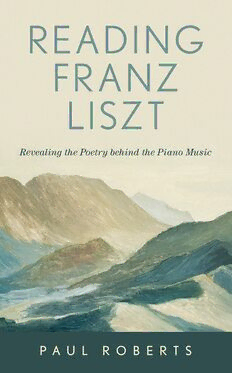
Reading Franz Liszt: Revealing the Poetry behind the Piano Music PDF
Preview Reading Franz Liszt: Revealing the Poetry behind the Piano Music
Reading Franz Liszt Portrait of Liszt by Henri Lehmann, oil, 1839. Musée Carnavalet, Histoire de Paris (CC0 1.0). Reading Franz Liszt Revealing the Poetry behind the Piano Music Paul Roberts Lanham • Boulder • New York • London Published by Amadeus Press An imprint of The Rowman & Littlefield Publishing Group, Inc. 4501 Forbes Boulevard, Suite 200, Lanham, Maryland 20706 www.rowman.com 86-90 Paul Street, London EC2A 4NE Copyright © 2022 by The Rowman & Littlefield Publishing Group, Inc. Clive James (trans.), The Divine Comedy, Canto 5, lines 149–160. Copyright © Clive James 2013. Reproduced with permission of the Licensor through PLSclear. All rights reserved. No part of this book may be reproduced in any form or by any electronic or mechanical means, including information storage and retrieval systems, without written permission from the publisher, except by a reviewer who may quote passages in a review. British Library Cataloguing in Publication Information Available Library of Congress Cataloging-in-Publication Data Names: Roberts, Paul, 1949– author. Title: Reading Franz Liszt : revealing the poetry behind the piano music / Paul Roberts. Description: Lanham : Amadeus Press, 2022. | Includes bibliographical references and index. | Summary: “Paul Roberts immerses readers in the world of Franz Liszt, megastar of Romanticism, through a vivid exploration of his most beloved pieces and literature that inspired them—from Petrarch’s love poetry to the sensibilities of Byron, Sénancour, and others. Roberts reveals the deeper essence of Liszt, recasting him as a composer of poetic feeling” —Provided by publisher. Identifiers: LCCN 2022004277 (print) | LCCN 2022004278 (ebook) | ISBN 9781538143346 (cloth) | ISBN 9781538143353 (epub) Subjects: LCSH: Liszt, Franz 1811–1886—Criticism and interpretation. | Piano music—19th century—History and criticism. | Music and literature. Classification: LCC ML410.L7 R63 2022 (print) | LCC ML410.L7 (ebook) | DDC 780.92—dc23 LC record available at https://lccn.loc.gov/2022004277 LC ebook record available at https://lccn.loc.gov/2022004278 The paper used in this publication meets the minimum requirements of American National Standard for Information Sciences—Permanence of Paper for Printed Library Materials, ANSI/NISO Z39.48-1992. To Jenny Directly, in itself, music signifies nothing, unless by convention and association. Music means nothing and yet means everything. One can make notes say what one will, grant them any power of analogy: they do not protest.1 —Vladimir Jankélévitch, Music and the Ineffable The more instrumental music progresses, develops and frees itself from its early limitations . . . the more it will cease to be a simple combination of tones and become a poetic language, one that, better than poetry itself perhaps, more readily expresses everything in us that transcends the commonplace, everything that eludes analysis. —Franz Liszt, An Artist’s Journey, Lettres d’un bachelier ès musique, 1835–18412 People talk so much about music and they say so little. I am absolutely certain that words are not adequate to it, and if ever I found that they were, I should eventually give up composition. [Music] fills one’s soul with a thousand better things than words. A piece of music that I love expresses thoughts to me that are not too imprecise to be framed in words, but too precise. —Felix Mendelssohn, Letter to Marc André Souchay, October 15, 18423 Contents List of Figures ix Acknowledgments xi Introduction: Making a Sound 1 1 Life, Literature, and Music 9 2 The Pianist as Actor 19 3 The Music of Desire—Petrarch Sonnets 27 4 The Question of Goethe’s Faust—Sonata in B minor 49 5 Music as Metaphor—Sonata in B minor 65 6 The Romantic Image—“Vallée d’Obermann” 79 7 The Aura of Byron—Années de pèlerinage—Suisse 95 8 Mental Theater—Années de pèlerinage—Suisse 115 9 Music and Poetry—The Dante Sonata 131 Appendix: Lamartine; Two Episodes from Lenau’s Faust; The Two St. Francis Legends; Thomas Wyatt’s translation of Petrarch’s sonnet “Pace non trovo”; A note on “Mazeppa” and an Afterthought 145 Notes 157 Select Bibliography 175 Index 179 About the Author 183 vii List of Figures 1.1 Cyprus trees at the Villa d’Este, painted by Jean-Honoré Fragonard 13 1.2 Liszt in 1886, the year he died 14 3.1 Illustration for Liszt’s Petrarch Sonnets, from an edition of 1858, showing Ed il suo lauro cresceva col suo amor per Laura engraved on the laurel stem and leaves 31 3.2 Petrarch Sonnet 47, mm. 1–19 38 3.3 Petrarch Sonnet 47, mm. 60–63 40 3.4 Petrarch Sonnet 104, mm. 5–20 41 3.5 Petrarch Sonnet 123, mm. 1–14 43 4.1 Delacroix, Faust in His Study. Lithograph. The caption reads, “You poor hollow skull, what does your grinning say?” —from Faust Part 1, l.664 53 4.2 Peter von Cornelius: Faust and Gretchen, lithograph 55 4.3 Faust Symphony, mm. 1–5 60 5.1 B minor Sonata, mm. 1–17 70 5.2 B minor Sonata, mm. 105–118 71 5.3 B minor Sonata, mm. 297–311 74 5.4 B minor Sonata, mm. 153–155 75 5.5 B minor Sonata, mm. 114–128 76 6.1 Title page of the second edition (1833) of Obermann by Etienne de Sénancour. This was the edition Liszt read. 85 6.2 “Vallée d’Obermann,” mm. 1–8 90 6.3 “Vallée d’Obermann,” mm. 70–74 91 6.4 “Vallée d’Obermann,” mm. 75–78 91 ix
